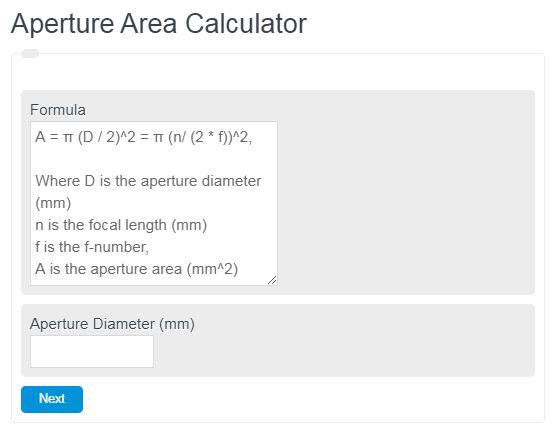Enter the focal length, aperture diameter, and the f-number into the calculator to determine the aperture area.
- Index of Refraction Calculator
- Angular Resolution Calculator
- Magnification Calculator
- Mirror Equation Calculator
- Thin Lens Calculator
- Exposure Value Calculator
- Focal Width/Length Calculator
Aperture Area Formula
The following formula is used to calculate the aperture area.
A = π (D / 2)^2 = π (n/ (2 * f))^2
- Where D is the aperture diameter (mm)
- n is the focal length (mm)
- f is the f-number,
- A is the aperture area (mm^2)
Aperture Area Definition
Aperture area refers to the surface area of an opening that allows light to pass through. It is an important parameter in various fields, particularly optics and photography.
Understanding the aperture area is important as it directly affects the amount of light that enters a system and influences the overall performance and quality of the image or measurement.
How to calculate aperture area?
How to calculate aperture area?
- First, determine the aperture diameter.
Measure the diameter of the aperture.
- Determine the focal length.
Measure the focal length mm.
- Determine the f-number.
Calculate the f-number.
- Finally, calculate aperture area.
Calculate the aperture area using the formula above.
FAQ
What factors influence the aperture area of a lens?
The aperture area of a lens is primarily influenced by the aperture diameter and the focal length. The f-number, which is the ratio of the lens’s focal length to the diameter of the aperture, also plays a critical role in defining the aperture area.
How does aperture area affect image quality in photography?
A larger aperture area allows more light to enter the camera, which can improve image brightness and clarity. It also affects the depth of field, enabling photographers to create images with a sharp subject and a blurred background, which is often desirable in portraits.
Can the aperture area be adjusted in all cameras and lenses?
Most modern cameras and lenses allow for adjustment of the aperture to control the amount of light entering the camera. However, the range of adjustment varies depending on the lens specifications. Some lenses offer a wider aperture range, allowing for greater flexibility in various lighting conditions.
Why is understanding aperture area important in optics and photography?
Understanding aperture area is crucial because it directly impacts the exposure and depth of field of an image, influencing the final outcome of a photograph. In optics, it determines the light-gathering capability and resolution of a system, affecting the visibility of details in the observed subject.

